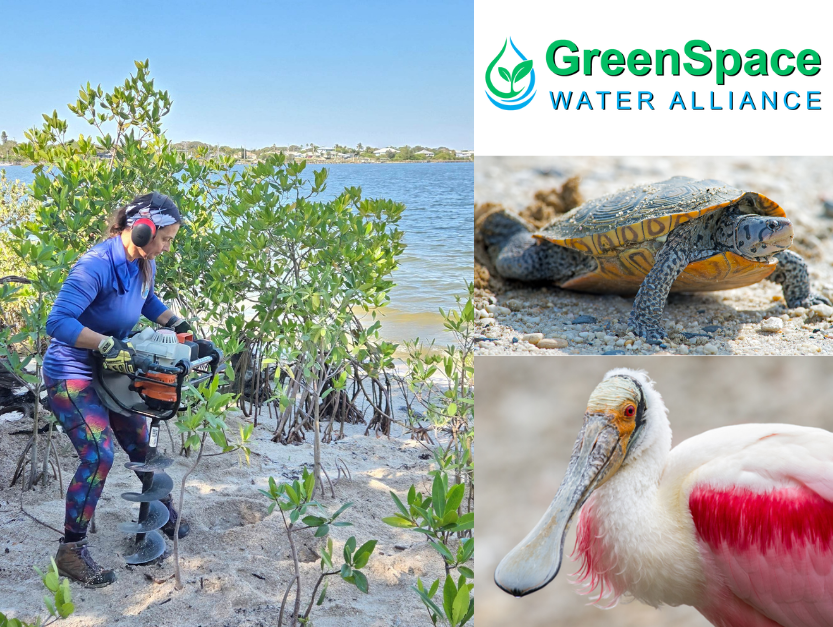Lagoon Island Restoration Success
On November 18, 2025, agriculture, academia, environmental non-profits, state regulatory and stewardship agencies, and dedicated individual community stakeholders came together to carry out an inspirational restoration initiative on an Indian River Lagoon spoil island, designated as a Critical Wildlife Area (CWA) by the Florida Fish & Wildlife Conservation Commission. This collaborative effort restored and expanded vital habitat for multiple Species of Greatest Conservation Need (SGCN), strengthening the ecological resilience of the estuary.
A Special thank you to all the GreenSpace Water Alliance donors, volunteers, and cheerleaders who made this project possible and successful.
Installation Directive Completed
18 juvenile mangroves ~variation of red, black, & white
15 mature red mangroves
30 buttonwood bushes
20 large buttonwood trees
*This installation will improve water quality and enhance screening cover, foraging, and nesting habitat for numerous species to thrive.
Acknowledgements
The project was completed thanks to the support provided by:
~Plant Life Farms
~Florida Fish & Wildlife Conservation Commission
~FDEP IRL Aquatic Preserves
~Restore Our Shores - Brevard Zoo
~Ocean Research & Conservation Association (ORCA)
~GreenSpace Water Alliance Donors & Volunteers
Please consider making an end-of-year contribution to help power more impactful projects in 2026.
Indian River Lagoon Spoil Island BC49 is a Critical Wildlife Area (CWA) due to its importance as a rookery island for many species of wading birds and seabirds, as well as providing habitat to other Species of Greatest Conservation Need, such as diamondback terrapins and banded tulip snails.
This 6-acre island in Brevard County, within the Indian River Lagoon, is a biodiversity hotspot and popular recreation area. Due to illegal cutting, this island has lost a significant area of mangroves and trees, which is why it was urgent for us to initiate this restoration project.
The inhabitants of Island BC49-Critical Wildlife Area, Thank You!
Bat species identified through acoustic monitoring: Big Brown Bats, Lasiurine, Myotis, Evening, Tri-colored, and Free-tailed Bats.
Species of Greatest Conservation Need (SGCN) ~Diamondback Terrapins and Banded Tulip Snails: Are wildlife species that require conservation attention due to low and declining populations, vulnerability, or other risk factors. These species are identified in Florida's Wildlife Action Plan. They are prioritized for conservation efforts because they are at risk, and conservation actions can help them.
Nesting seabirds and wading birds: Brown Pelican, Wood Stork, Roseate Spoonbill, Little Blue Heron, Tricolored Heron, Great Blue Heron, Great Egret, Snowy Egret, Cattle Egret, White Ibis, Black-crowned Night Heron, Anhinga, Double-crested Cormorant, and Glossy Ibis.
*Due to the high number of nesting birds on this island, large mangrove and buttonwood trees were installed to avoid damage by nesting birds. Larger trees also fill in the canopy at restoration areas, providing nesting substrate and cover for birds sooner, and have an increased likelihood of survival. To avoid disturbance to nesting wading birds and seabirds, all planting activity is conducted during the non-breeding season.
Your end-of-year support can spark even more meaningful projects next year.
To make a donation by mail: Please make checks payable to GreenSpace Water Alliance and send to: GreenSpace Water Alliance, 5445 Murrell Rd, Ste 102, Rockledge, FL 32955.
We hope this project inspires you to stay involved, spread the word, and continue caring for the wildlife, waterways and green spaces that sustain us all. Thank you for showing up, for giving so much, and for being part of the solution.
With heartfelt appreciation and gratitude,






